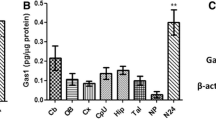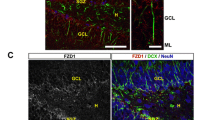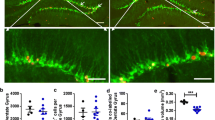Abstract
Tumor necrosis factor-related apoptosis-inducing ligand or Apo2 ligand is a member of the tumor necrosis factor superfamily of cytokines that induces apoptosis upon binding to its death domain-containing transmembrane receptors, death receptors 4 and 5 (DR4, DR5). However, DR5 is also expressed in the developing CNS where it appears to play a role unrelated to apoptosis, and instead may be involved in the regulation of neurogenesis. We report on the distribution of DR5 expression in mouse hippocampus, cerebellum, and rostral migratory stream (RMS) of olfactory bulb from embryonic (E) day 16 (E16) to postnatal (P) day (P180). At E16, DR5-positive cells were distributed widely in embryonic hippocampus with strong immunostaining in the developing dentate gyrus. In newborn hippocampus, DR5-positive cells were predominantly located in proliferative zones, such as dentate gyrus, subventricular zone, and RMS. After postnatal day 7 (P7), the number of DR5-positive cells decreased, and cells with intense fluorescence were primarily restricted to the subgranular layer (SGL), although the granular cell layer showed weak fluorescence. After P30, only few DR5-positive cells were found in SGL, and mature granule cells were negative for DR5 expression. To address whether DR5 expression is a restricted to progenitor cells and newborn neurons, we performed 5-bromo-deoxyuridine labeling. We report that proliferative cells in the SGL selectively express DR5, with lower levels of expression in cells positive for doublecortin, a marker of newborn neurons. In addition, the stem cells in intestine, cerebellum, and RMS were also demonstrated to be DR5-positive. In the meantime, in cerebellum, DR5-positive cells were also positive for glial fibrillary acidic protein, a marker of proliferative Bergmann cells. We conclude that DR5 is selectively expressed by neuroprogenitor cells and newborn neurons, suggesting that the DR5 death receptor is likely to play a key role in neuroproliferation and differentiation.




Similar content being viewed by others
References
Abdulghani J, El-Deiry WS (2010) TRAIL receptor signaling and therapeutics. Expert Opin Ther Targets 14:1091–1108
Aguirre A, Rubio ME, Gallo V (2010) Notch and EGFR pathway interaction regulates neural stem cell number and self-renewal. Nature 467:323–327
Alcock J, Scotting P, Sottile V (2007) Bergmann glia as putative stem cells of the mature cerebellum. Med Hypotheses 69:341–345
Ashkenazi A, Dixit VM (1998) Death receptors: signaling and modulation. Science 281:1305–1308
Bai X, Williams JL, Greenwood SL, Baker PN, Aplin JD, Crocker IP (2009) A placental protective role for trophoblast-derived TNF-related apoptosis-inducing ligand (TRAIL). Placenta 30:855–860
Bellail AC, Qi L, Mulligan P, Chhabra V, Hao C (2009) TRAIL agonists on clinical trials for cancer therapy: the promises and the challenges. Rev Recent Clin Trials 4:34–41
Belyanskaya LL, Ziogas A, Hopkins-Donaldson S, Kurtz S, Simon HU, Stahel R, Zangemeister-Wittke U (2008) TRAIL-induced survival and proliferation of SCLC cells is mediated by ERK and dependent on TRAIL-R2/DR5 expression in the absence of caspase-8. Lung Cancer 60:355–365
Bisson I, Prowse DM (2009) WNT signaling regulates self-renewal and differentiation of prostate cancer cells with stem cell characteristics. Cell Res 19:683–697
Brand AH, Livesey FJ (2011) Neural stem cell biology in vertebrates and invertebrates: more alike than different? Neuron 70:719–729
Buchsbaum DJ, Forero-Torres A, LoBuglio AF (2007) TRAIL-receptor antibodies as a potential cancer treatment. Future Oncol 3:405–409
Budd RC (2002) Death receptors couple to both cell proliferation and apoptosis. J Clin Invest 109:437–441
Chattergoon MA, Muthumani K, Tamura Y, Ramanathan M, Shames JP, Saulino V, Robinson TM, Montaner LJ, Weiner DB (2008) DR5 activation of caspase-8 induces DC maturation and immune enhancement in vivo. Mol Ther 16:419–426
Chaudhary PM, Eby M, Jasmin A, Bookwalter A, Murray J, Hood L (1997) Death receptor 5, a new member of the TNFR family, and DR4 induce FADD-dependent apoptosis and activate the NF-kappaB pathway. Immunity 7:821–830
Chen B, Ma B, Yang S, Xing X, Gu R, Hu Y (2009) DR5 and DcR2 are expressed in human lumbar intervertebral discs. Spine 34:E677–E681
Clarke RB (2006) Ovarian steroids and the human breast: regulation of stem cells and cell proliferation. Maturitas 54:327–334
Falschlehner C, Ganten TM, Koschny R, Schaefer U, Walczak H (2009) TRAIL and other TRAIL receptor agonists as novel cancer therapeutics. Adv Exp Med Biol 647:195–206
Harrison DC, Roberts J, Campbell CA, Crook B, Davis R, Deen K, Meakin J, Michalovich D, Price J, Stammers M, Maycox PR (2000) TR3 death receptor expression in the normal and ischaemic brain. Neuroscience 96:147–160
Henson ES, Johnston JB, Gibson SB (2008) The role of TRAIL death receptors in the treatment of hematological malignancies. Leuk Lymphoma 49:27–35
Huang Y, Jin H, Liu Y, Zhou J, Ding J, Cheng KW, Yu Y, Feng Y (2010) FSH inhibits ovarian cancer cell apoptosis by up-regulating survivin and down-regulating PDCD6 and DR5. Endocr Relat Cancer 18:13–26
Hymowitz SG, Christinger HW, Fuh G, Ultsch M, O’Connell M, Kelley RF, Ashkenazi A, de Vos AM (1999) Triggering cell death: the crystal structure of Apo2L/TRAIL in a complex with death receptor 5. Mol Cell 4:563–571
Ikeda T, Hirata S, Fukushima S, Matsunaga Y, Ito T, Uchino M, Nishimura Y, Senju S (2010) Dual effects of TRAIL in suppression of autoimmunity: the inhibition of Th1 cells and the promotion of regulatory T cells. J Immunol 185:5259–5267
Imayoshi I, Sakamoto M, Ohtsuka T, Kageyama R (2009) Continuous neurogenesis in the adult brain. Dev Growth Differ 51:379–386
Lan YH, Wu YC, Wu KW, Chung JG, Lu CC, Chen YL, Wu TS, Yang JS (2011) Death receptor 5-mediated TNFR family signaling pathways modulate γ-humulene-induced apoptosis in human colorectal cancer HT29 cells. Oncol Rep 25:419–424
Leithner K, Stacher E, Wurm R, Ploner F, Quehenberger F, Wohlkoenig C, Bálint Z, Polachova J, Olschewski A, Samonigg H (2009) Nuclear and cytoplasmic death receptor 5 as prognostic factors in patients with non-small cell lung cancer treated with chemotherapy. Lung Cancer 65:98–104
Lepage C, Léger DY, Bertrand J, Martin F, Beneytout JL, Liagre B (2011) Diosgenin induces death receptor-5 through activation of p38 pathway and promotes TRAIL-induced apoptosis in colon cancer cells. Cancer Lett 301:193–202
Lin CW, Manshouri T, Jilani I, Neuberg D, Patel K, Kantarjian H, Andreeff M, Estrov Z, Beran M, Keating M (2002) Proliferation and apoptosis in acute and chronic leukemias and myelodysplastic syndrome. Leuk Res 26:551–559
Lin SC, Lo YC, Wu H (2010) Helical assembly in the MyD88-IRAK4-IRAK2 complex in TLR/IL-1R signalling. Nature 465:885–890
Loreto C, Almeida LE, Migliore MR, Caltabiano M, Leonardi R (2010) TRAIL, DR5 and caspase 3-dependent apoptosis in vessels of diseased human temporomandibular joint disc. An immunohistochemical study. Eur J Histochem 54:e40
Lossi L, Alasia S, Salio C, Merighi A (2009) Cell death and proliferation in acute slices and organotypic cultures of mammalian CNS. Prog Neurobiol 88:221–245
MacFarlane M (2003) TRAIL-induced signalling and apoptosis. Toxicol Lett 139:n89–n97
Maduro JH, Noordhuis MG, ten Hoor KA, Pras E, Arts HJ, Eijsink JJ, Hollema H, Mom CH, de Jong S, de Vries EG (2009) The prognostic value of TRAIL and its death receptors in cervical cancer. Int J Radiat Oncol Biol Phys 75:203–211
Mahalingam D, Szegezdi E, Keane M, Jong S, Samali A (2009) TRAIL receptor signalling and modulation: are we on the right TRAIL? Cancer Treat Rev 35:280–288
Mongiat LA, Schinder AF (2011) Adult neurogenesis and the plasticity of the dentate gyrus network. Eur J Neurosci 33:1055–1061
Mori H, Sugie S, Yoshimi N, Hara A, Tanaka T (1999) Control of cell proliferation in cancer prevention. Mutat Res 428:291–298
Ohtsuki T, Kikuchi H, Koyano T, Kowithayakorn T, Sakai T, Ishibashi M (2009) Death receptor 5 promoter-enhancing compounds isolated from Catimbium speciosum and their enhancement effect on TRAIL-induced apoptosis. Bioorg Med Chem 17:6748–6754
Oldenhuis CN, Stegehuis JH, Walenkamp AM, de Jong S, de Vries EG (2008) Targeting TRAIL death receptors. Curr Opin Pharmacol 8:433–439
Ozawa F, Friess H, Kleeff J, Xu ZW, Zimmermann A, Sheikh MS, Büchler MW (2001) Effects and expression of TRAIL and its apoptosis-promoting receptors in human pancreatic cancer. Cancer Lett 163:71–81
Pakala R, Pakala R, Sheng WL, Benedict CR (1999) Serotonin fails to induce proliferation of endothelial cells preloaded with eicosapentaenoic acid and docosahexaenoic acid. Atherosclerosis 145:137–146
Park SJ, Bijangi-Vishehsaraei K, Safa AR (2010) Selective TRAIL-triggered apoptosis due to overexpression of TRAIL death receptor 5 (DR5) in P-glycoprotein-bearing multidrug resistant CEM/VBL1000 human leukemia cells. Int J Biochem Mol Biol 1:90–100
Peng H, Huang Y, Duan Z, Erdmann N, Xu D, Herek S, Zheng J (2005) Cellular IAP1 regulates TRAIL-induced apoptosis in human fetal cortical neural progenitor cells. J Neurosci Res 82:295–305
Sloviter RS (2002) Apoptosis: a guide for the perplexed. Trends Pharmacol Sci 23:19–24
Spierings DC, de Vries EG, Vellenga E, van den Heuvel FA, Koornstra JJ, Wesseling J, Hollema H, de Jong S (2004) Tissue distribution of the death ligand TRAIL and its receptors. J Histochem Cytochem 52:821–831
Szegezdi E, O’Reilly A, Davy Y, Vawda R, Taylor DL, Murphy M, Samali A, Mehmet H (2009) Stem cells are resistant to TRAIL receptor-mediated apoptosis. J Cell Mol Med 13:4409–4414
Takeda K, Kojima Y, Ikejima K, Harada K, Yamashina S, Okumura K, Aoyama T, Frese S, Ikeda H, Haynes NM (2008) Death receptor 5 mediated-apoptosis contributes to cholestatic liver disease. Proc Natl Acad Sci USA 105:10895–10900
Tang W, Wang W, Zhang Y, Liu S, Liu Y, Zheng D (2009) TRAIL receptor mediates inflammatory cytokine release in an NF-kappaB-dependent manner. Cell Res 19:758–767
Thoolen B (1990) BrdUrd labeling of S-phase cells in testes and small intestine of mice, using microwave irradiation for immunogold-silver staining: an immunocytochemical study. J Histochem Cytochem 38:267–273
Whitman MC, Greer CA (2009) Adult neurogenesis and the olfactory system. Prog Neurobiol 89:162–175
Wu GS (2009) TRAIL as a target in anti-cancer therapy. Cancer Lett 285:1–5
Zhang Y, Zhang B (2008) TRAIL resistance of breast cancer cells is associated with constitutive endocytosis of death receptors 4 and 5. Mol Cancer Res 6:m1861–m1871
Zhang Y, Niu B, Yu D, Cheng X, Liu B, Deng J (2010) Radial glial cells and the lamination of the cerebellar cortex. Brain Struct Funct 215:115–122
Acknowledgment
This study was supported by the National Natural Science Foundation of China (Grant No. 30670688, 30771140, 31070952).
Author information
Authors and Affiliations
Corresponding author
Rights and permissions
About this article
Cite this article
Niu, Y., Li, Y., Zang, J. et al. Death Receptor 5 and Neuroproliferation. Cell Mol Neurobiol 32, 255–265 (2012). https://doi.org/10.1007/s10571-011-9757-3
Received:
Accepted:
Published:
Issue Date:
DOI: https://doi.org/10.1007/s10571-011-9757-3




